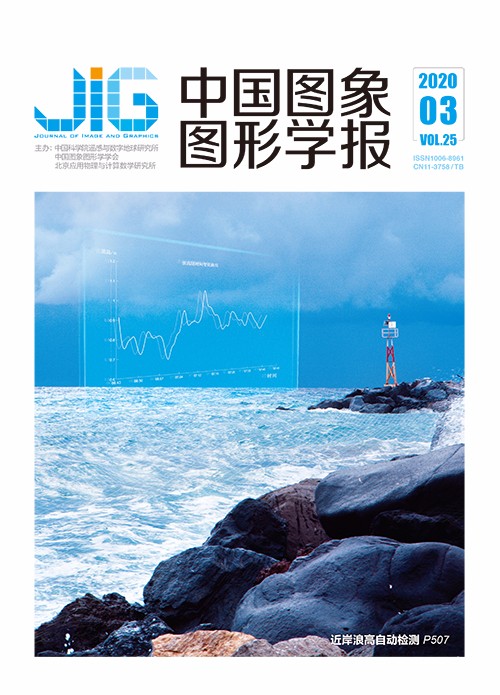
结合Gabor滤波器和扩展LTP算子的无监督纹理图像分割
摘 要
目的 现实中的纹理往往具有类型多样、形态多变、结构复杂等特点,直接影响到纹理图像分割的准确性。传统的无监督纹理图像分割算法具有一定的局限性,不能很好地提取稳定的纹理特征。本文提出了基于Gabor滤波器和改进的LTP(local ternary pattern)算子的针对复杂纹理图像的纹理特征提取算法。方法 利用Gabor滤波器和扩展LTP算子分别提取相同或相似纹理模式的纹理特征和纹理的差异性特征,并将这些特征融入到水平集框架中对纹理图像进行分割。结果 通过实验表明,对纹理方向及尺度变化较大的图像、复杂背景下的纹理图像以及弱纹理模式的图像,本文方法整体分割结果明显优于传统的Gabor滤波器、结构张量、拓展结构张量、局部相似度因子等纹理分割方法得到的结果。同时,将本文方法与基于LTP的方法进行对比,分割结果依然更优。在量化指标方面,将本文方法与各种无监督的纹理分割方法就分割准确度进行对比,结果表明,在典型的纹理图像上,本文方法准确度达到97%以上,高于其他方法的分割准确度。结论 提出了一种结合Gabor滤波器和扩展LTP算子的无监督多特征的纹理图像分割方法,能够较好地提取相似纹理模式的特征和纹理的差异性特征,且这些纹理特征可以很好地融合到水平集框架中,对真实世界复杂纹理图像能够得到良好的分割效果。
关键词
Unsupervised segmenting texture images based on Gabor filters and extended LTP operator
Ma Rui1,2, Zhou Li2(1.Department of Information and Intelligent Engineering, Anhui Vocational College of Electronics and Information Technology, Bengbu 233030, China;2.School of Computer Science and Information Technology, Hefei University of Technology, Hefei 230601, China) Abstract
Objective The texture is often characterized by various unregular types, varied shapes, and complex structures, which directly weaken the accuracy of texture image segmentation. The semantic segmentation methods based on deep learning need benchmark training sets. Constructing the training sets composed by the complex and diverse texture images is difficult. Therefore, utilizing the unsupervised image segmentation methods to solve the problem of texture segmentation is necessary. However, the traditional unsupervised texture image segmentation algorithms have limitations and cannot be used to effect tivelyextract the stable texture features. Method Based on the idea that the Gabor operator can extract the texture diversity features and the local ternary pattern (LTP) operators imply the threshold differences, combining Gabor filters with extended LTP operators is proposed to describe texture diversity features in this paper. Gabor filter is used to extract the texture features of the same or similar texture patterns. Then, the texture difference features are extracted. Compared with the traditional LTP, the main advantages of the extended LTP operator are embodied in two aspects.On the one hand, the extended size make the LTP operator effective in image segmentation based on the size features of the segmented image.On the other hand, the weights are given to each position of the extended LTP operator. The exponential weight differences are given according to the distances between each position and the central point. Finally, these extracted features are integrated into the level set frame to segment the texture image. The advantages of the proposed method are described as follows:First, the extended LTP operator can effectively extract the texture difference features of local regions. Second, the Gabor filter and extended LTP operator are complementary. The main contributions of the proposed method in this paper are elaborated in the following:1) By improving the traditional LTP operator, we propose an extended LTP operator to extract the texture difference features of pixels in complex images. 2) The Gabor filter and extended LTP operator are complementary. The extended LTP operator and Gabor filter are combined and incorporated into the level set method. The extended LTP operator extracts the texture difference information of complex images, while the Gabor method detects similar information, such as similar frequency, size, and direction of images. The two operators have obvious complementary characteristics. Therefore, the extended LTP operator and Gabor filter are combined to extract the texture features of complex images in a complementary manner. The two operators are integrated into the level set method to effectively solve the segmentation problem of the complex images. Result In the experimental results section, the proposed method is compared with the classical unsupervised texture segmentation methods, including the methods based on Gabor filter, structure tensor, extended structure tensor, and local similarity factor. By segmenting all kinds of texture images, such as the images with varied texture directions and sizes, the images with the complex background, and the images with the weak texture features, the proposed method achieved better segmentation results than that of the traditional Gabor filter, where the structure tensor was expanded with the local similarity factor. By comparing the proposed method with the LTP-based method in this study, we found that the segmentation results of the proposed method are still better than those of the LTP-based method. In the experimental results section, the segmentation results of several commonly used level set methods (including Gabor filter, structure tensor, extended structure tensor, and robust local similarity factor (RLSF)) are presented and compared with the segmentation results of the proposed method. Fig.8-10 show the advantages of the proposed method for segmentation of three types of texture images. More intuitively, specific quantitative results of segmentation accuracy were given for comparison between the proposed method and the various unsupervised texture segmentation methods in this study. On some typical texture images, the accuracy of the proposed method is more than 97%, which is higher than that of the other methods. Conclusion An unsupervised multi-feature-based texture image segmentation algorithm is proposed in this paper. This method can be utilized to extract the features of the similar texture patterns and the texture differences by combining the Gabor filter and extended LTP operator. These texture features were integrated into the level set framework to segment the texture images accurately. Several experiments show that the proposed method can achieve desirable segmentation results for complex texture images in the real world. The advantages and disadvantages of the proposed unsupervised segmentation method were analyzed and the methods based on deep learning in the conclusion section. Compared with the segmentation methods based on deep learning, the proposed method is unsupervised, and therefore does not need prior or training information. However, the segmentation methods based on deep learning relies on training information heavily. Obtaining the training information of the complex texture images is difficult. At the same time, future research ideas are elaborated. Considering some structural relevance of texture images, our future work aims to focus on the extraction and analysis of texture structures to obtain improved segmentation effects.
Keywords
|



 中国图象图形学报 │ 京ICP备05080539号-4 │ 本系统由
中国图象图形学报 │ 京ICP备05080539号-4 │ 本系统由